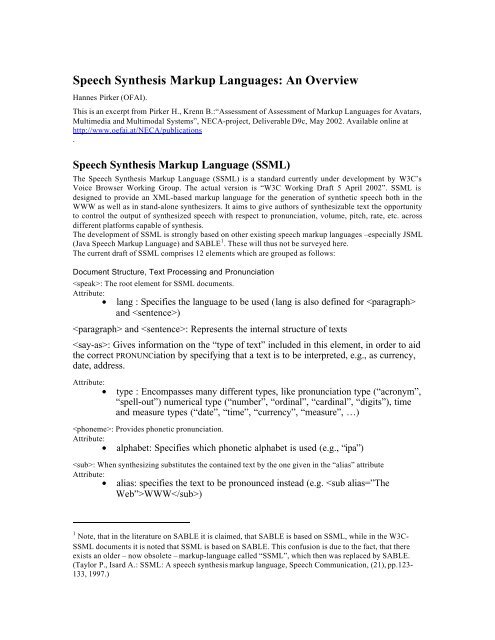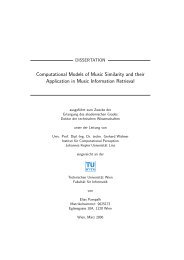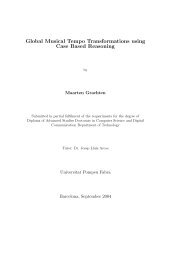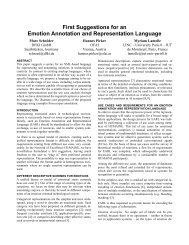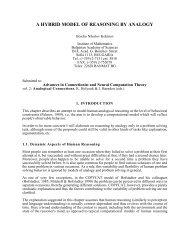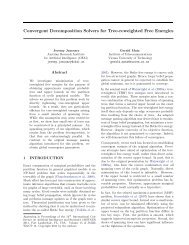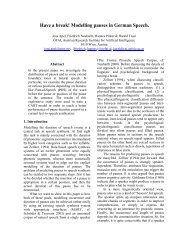Speech Synthesis Markup Languages: An Overview and ... - OFAI
Speech Synthesis Markup Languages: An Overview and ... - OFAI
Speech Synthesis Markup Languages: An Overview and ... - OFAI
You also want an ePaper? Increase the reach of your titles
YUMPU automatically turns print PDFs into web optimized ePapers that Google loves.
<strong>Speech</strong> <strong>Synthesis</strong> <strong>Markup</strong> <strong>Languages</strong>: <strong>An</strong> <strong>Overview</strong><br />
Hannes Pirker (<strong>OFAI</strong>).<br />
This is an excerpt from Pirker H., Krenn B.:“Assessment of Assessment of <strong>Markup</strong> <strong>Languages</strong> for Avatars,<br />
Multimedia <strong>and</strong> Multimodal Systems”, NECA-project, Deliverable D9c, May 2002. Available online at<br />
http://www.oefai.at/NECA/publications<br />
.<br />
<strong>Speech</strong> <strong>Synthesis</strong> <strong>Markup</strong> Language (SSML)<br />
The <strong>Speech</strong> <strong>Synthesis</strong> <strong>Markup</strong> Language (SSML) is a st<strong>and</strong>ard currently under development by W3C’s<br />
Voice Browser Working Group. The actual version is “W3C Working Draft 5 April 2002”. SSML is<br />
designed to provide an XML-based markup language for the generation of synthetic speech both in the<br />
WWW as well as in st<strong>and</strong>-alone synthesizers. It aims to give authors of synthesizable text the opportunity<br />
to control the output of synthesized speech with respect to pronunciation, volume, pitch, rate, etc. across<br />
different platforms capable of synthesis.<br />
The development of SSML is strongly based on other existing speech markup languages –especially JSML<br />
(Java <strong>Speech</strong> <strong>Markup</strong> Language) <strong>and</strong> SABLE 1 . These will thus not be surveyed here.<br />
The current draft of SSML comprises 12 elements which are grouped as follows:<br />
Document Structure, Text Processing <strong>and</strong> Pronunciation<br />
: The root element for SSML documents.<br />
Attribute:<br />
• lang : Specifies the language to be used (lang is also defined for <br />
<strong>and</strong> )<br />
<strong>and</strong> : Represents the internal structure of texts<br />
: Gives information on the “type of text” included in this element, in order to aid<br />
the correct PRONUNCiation by specifying that a text is to be interpreted, e.g., as currency,<br />
date, address.<br />
Attribute:<br />
• type : Encompasses many different types, like pronunciation type (“acronym”,<br />
“spell-out”) numerical type (“number”, “ordinal”, “cardinal”, “digits”), time<br />
<strong>and</strong> measure types (“date”, “time”, “currency”, “measure”, …)<br />
: Provides phonetic pronunciation.<br />
Attribute:<br />
• alphabet: Specifies which phonetic alphabet is used (e.g., “ipa”)<br />
: When synthesizing substitutes the contained text by the one given in the “alias” attribute<br />
Attribute:<br />
• alias: specifies the text to be pronounced instead (e.g. WWW)<br />
1 Note, that in the literature on SABLE it is claimed, that SABLE is based on SSML, while in the W3C-<br />
SSML documents it is noted that SSML is based on SABLE. This confusion is due to the fact, that there<br />
exists an older – now obsolete – markup-language called “SSML”, which then was replaced by SABLE.<br />
(Taylor P., Isard A.: SSML: A speech synthesis markup language, <strong>Speech</strong> Communication, (21), pp.123-<br />
133, 1997.)
Prosody <strong>and</strong> Style<br />
: Specifies the voice to be used<br />
Attributes:<br />
• lang (optional language specification)<br />
• gender (“male”, “female”, “neutral”)<br />
• age (preferred age of the voice to speak the contained text – integer)<br />
• name (platform-specific voice name)<br />
• variant (indicating a preferred variant of the selected voice – integer)<br />
: The contained text is to be spoken with emphasis.<br />
Attribute:<br />
• level: strength of emphasis (“none”, “reduced”, “moderate”, “strong”)<br />
: <strong>An</strong> empty element controlling pausing <strong>and</strong> realisation of prosodic boundaries<br />
Attributes:<br />
• size (strength of boundary (“none”, “small”, “medium”, “large” – optional)<br />
• time (duration of a pause in seconds or milliseconds – optional)<br />
: Permit control over the prosody to be used<br />
Attributes:<br />
• pitch (the baseline in Hertz, a relative change or the values “default”, “low”,<br />
“medium”, “high”)<br />
• contour (specify a concrete pitch contour)<br />
• range (the pitch range in Hertz, a relative change or the values “default”,<br />
“low”, “medium”, “high”)<br />
• rate (the speech rate in words per minute. A relative change or the values<br />
“default”, “slow”, “medium”, “fast”)<br />
• duration (the time to be used to pronounce an item in seconds or milliseconds)<br />
• volume (in a range from 0.0 to 100.0, a relative change or the values<br />
“default”, “silent”, “soft”, “medium”, “loud”)<br />
Other Elements<br />
: Embed an audio file, which is replayed when the element is reached<br />
Attribute:<br />
• src (specify the name of the audio file)<br />
Place a marker in the text to be used either for internal reference within the SSML document or to<br />
be used externally by other documents. When speech synthesis reaches a element it issues an event<br />
with its name<br />
Attribute:<br />
• name (string issued as event name when mark is reached – required)<br />
Online References:
The actual version of SSML is always to be found at: http://www.w3.org/TR/speech-synthesis<br />
Microsoft SAPI TTS XML<br />
Within its <strong>Speech</strong> Application Programming Interface (SAPI), Microsoft offers its own interface to speech<br />
synthesis. The current version is SAPI 5.1. Though SAPI itself is not a markup language SAPI 5.1 offers an<br />
XML based language for TTS which is explicitly inspired by SABLE (one of SSML’s ancestors) but is not<br />
aiming for real compatibility with SABLE. As it has to be taken into account, that Microsoft’s power on the<br />
market tends to apply some pressure on every st<strong>and</strong>ardization effort, we will perform a short comparison of<br />
SAPI 5.1. TTS XML with SSML.<br />
Roughly speaking, many of the differences are only minor deviations in terminology (e.g. <br />
<strong>and</strong> are basically identical in function). Some differences arise from the fact that a<br />
functionality is expressed in terms of its own element in the one markup-language but in terms of an<br />
attribute in the other (e.g. <strong>and</strong> have the same effect). Generally<br />
speaking the major differences in functionality can be summarized as follows: SABLE offers finer-grained<br />
control for the specification of factors influencing prosody (e.g., several levels of strength in ,<br />
several levels of size in ) as well as concrete control over the acoustic parameters (i.e., fundamental<br />
frequency in Hertz <strong>and</strong> duration in milliseconds) for specifying prosody.<br />
Online References:<br />
http://msdn.microsoft.com/library/default.asp?url=/library/en-us/sapi/Welcome.asp<br />
SML in VHML<br />
VHML (Virtual Human <strong>Markup</strong> Language) is an attempt to combine existing markup-languages developed<br />
for the various aspects of human-computer interaction (e.g. facial expression, body animation, emotional<br />
representation) into a unified specification language. The sub-part of VHML concerned with the markup<br />
for speech synthesis is called <strong>Speech</strong> <strong>Markup</strong> Language (SML) <strong>and</strong> is – according to the current “VHML<br />
Working Draft v0.3” from 21.Oct.2001 – based on W3C’s SSML. Comparing SML to the current version<br />
of SSML points out, that roughly speaking SML currently is a slightly downsized variant of SSML. The<br />
most important difference to SSML <strong>and</strong> SAPI is, that it foresees the labelling of the speaker’s emotion via<br />
VHML’s Emotional <strong>Markup</strong> Language (EML). Emotion-tags specified in EML are inherited by SML <strong>and</strong><br />
are thus visible to the speech synthesis.<br />
Comparison of SSML, SML <strong>and</strong> SAPI<br />
In Table 1 a rough comparison of functionality <strong>and</strong> tag-sets of SSML, its VHML-derivate SML, <strong>and</strong> MS-<br />
SAPI is performed. “N.A.” denotes “Not available”. Elements <strong>and</strong> their meaning are usually described in<br />
more detail in the section on SSML.<br />
Functionality SSML SML SAPI Remarks<br />
Root element N.A. <br />
Defining language<br />
Structuring of text<br />
Specifying how a<br />
certain content is to<br />
be interpreted.<br />
Attributes are, e.g.,<br />
email, number,<br />
ordinal<br />
“lang” attribute for<br />
<br />
<strong>and</strong> <br />
<br />
<br />
N.A.<br />
<br />
-element or<br />
“lang”-attribute of<br />
element<br />
N.A.<br />
<br />
is<br />
not part of SML<br />
proper, but available<br />
in VHML
Functionality SSML SML SAPI Remarks<br />
Specify, that<br />
contained text is to<br />
be spelled out (e.g.<br />
“USA”)<br />
<br />
<br />
Provide part of<br />
speech information<br />
Provide phonetic<br />
pronunciation<br />
N.A. NA . Values<br />
are: “Unknown”,<br />
“Noun”, “Verb”,<br />
“Modifier”,<br />
“Function”,<br />
“Interjection”<br />
<br />
Indicate that a<br />
specified text<br />
substitutes another<br />
N.A. N.A.<br />
Specify/change the<br />
voice used<br />
<br />
Attributes are lang,<br />
gender, age, variant,<br />
name<br />
<br />
<br />
Mark content as<br />
emphasized<br />
Control of<br />
pausing/prosodic<br />
boundaries.<br />
Control prosody.<br />
<br />
Attribute: level<br />
[Values: “strong”,<br />
“moderate”, “none”,<br />
“reduced”]<br />
<br />
Attribute: size<br />
[Values: “none”,<br />
“small”, “medium”,<br />
“large”]<br />
Attribute: time<br />
(optional): duration<br />
of pause<br />
<br />
Attributes: pitch,<br />
contour, range, rate,<br />
duration, volume<br />
<br />
extends SSML with<br />
Attribute: affect<br />
[Values “pitch”,<br />
“duration”, “both”]<br />
<strong>and</strong> target [the<br />
phoneme to be<br />
emphasized]<br />
<br />
<br />
<br />
<br />
Inserts silence of<br />
100ms length<br />
<br />
<br />
<br />
In SAPI only<br />
available<br />
w/o further<br />
differentiation.<br />
In SML the syllable<br />
<strong>and</strong> optionally the<br />
prosodic means to<br />
signal emphasis <strong>and</strong><br />
the exact position of<br />
the phoneme to be<br />
emphasized can be<br />
specified.<br />
In SAPI only length<br />
of pause specified –<br />
no further<br />
differentiation<br />
SSML allows for a<br />
finer grained control<br />
of prosody.<br />
Equivalents to<br />
“contour” <strong>and</strong><br />
“duration” are<br />
missing entirely in
Functionality SSML SML SAPI Remarks<br />
SAPI<br />
Insert arbitrary<br />
audio file (e.g.,<br />
recorded speech,<br />
music)<br />
Specify emotion of<br />
speaker<br />
NOT AVAILABLE is<br />
not part of SML<br />
proper but of VHML<br />
– it allows for<br />
embedding of<br />
foreign filetypes in<br />
general<br />
N.A.<br />
N.A.<br />
Place a marker in<br />
the text: <strong>An</strong> event<br />
will be issued by the<br />
synthesizer when<br />
reaching the mark<br />
can<br />
have content,<br />
<br />
has to be empty<br />
Table 1 Summary of all attributes in SSML, SML, <strong>and</strong> SAPI<br />
This table once again reveals the close similarities between SSML <strong>and</strong> SML. SAPI basically offers a subset<br />
of SSML’s labels. Many of the remaining differences are only syntactic.


